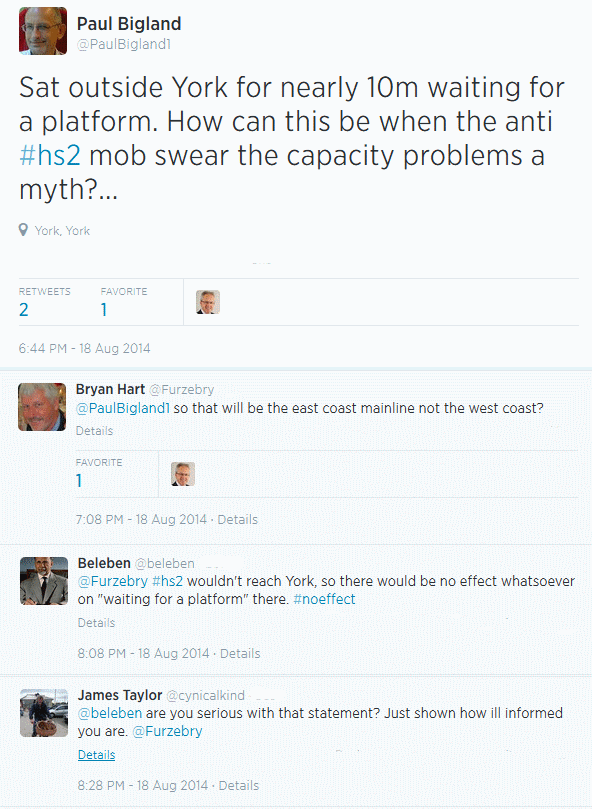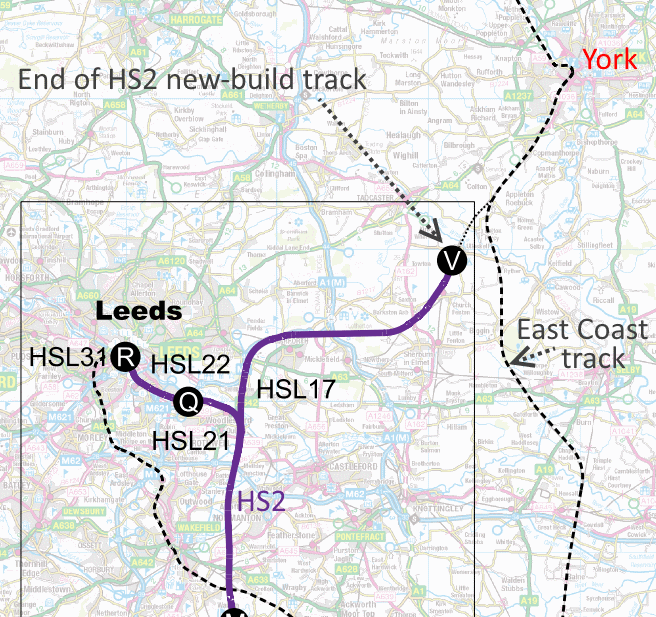Alas poor Jorvik
HS2 is endlessly revisited and repackaged as a panacea solution to the claimed constraints on rail’s future performance and capabilities, noted Newcastle University rail research associate Philip Mortimer (22 July 2014).
Here’s an example of the phenomenon.

Despite not reaching York, the new-build HS2 track would somehow mean ‘an end to platforming delays at York’

The HS2 Y network new-build track would not reach York, so there would be no effect on platforming delays there
As you rightly imply beleben the simpler explanation is that York is a major junction station that does not have enough platforms to meet its current (peak time) operational requirements, and that HS2 will act to accentuate this problem further, not cure it.
Therefore why not add the cost of doubling the size of York station to the HS2 bill (York West added to the existing York [East]) with a multi-million pound state of the art mass transit system connecting up the two halves of the station. Perhaps while you are at it increase the line capacity coming in from the North, to allow for more non-stopping HS2 bound through trains (and other non-stopping through ECML trains). With this added investment the HS2 scheme will solve the congestion problems at York, even if doubling the size of the station is going slightly over the top. However gold plated over the top solutions is what HS2 is all about.
I generally support the case for more investment in our railways. My main complaint with HS2 is that the promoters have not published a business case/plan to tell us all how much the new lines will cost in terms of public subsidy. Systems engineers should have been involved from the start (to dispassionately compare a wide array of investment options) to help find which investments give the best cost-benefit overall.
The long term future of our railways will be much more secure (and need far less public subsidy) once the HS2 project collapses under the weight of its own incoherence, and a multitude of other far cheaper cost effective alternatives rise phoenix like to replace it. We need to maximise benefit for a given cost, not maximise cost for a given claimed benefit.
James Arathoon
August 19, 2014 at 2:38 pm
If you had only a billion pounds to spend it would certainly be better value to do the sort of piecemeal improvements that you suggest, but over the long terms that governments can and will amortise costs it can be a false economy. The law of diminishing returns means that further upgrades will deliver less and less for every pound spent, and the government is forecasting that usage of the railways will increase so much that the law of diminishing returns will make it prohibitively expensive to continue upgrading in order to meet this extra demand. Given that HS2 Ltd’s projections are based upon 2% year-on-year passenger number growth, and that real life figures have been around double that, it appears that the increase in passenger numbers is not only possible but a matter of certainty given the laws of compound increases. If you had a crystal ball and you knew that HS2 Ltd’s projections were conservative, would you accept that a radical, non-piecemeal solution may actually be the best overall decision in terms of overall cost, disruption and other benefits to the country?
I don’t think the HS2 plans can be counted as incoherent compared to the nebulous WCML upgrades proposed by 51m et al. The technical specification of HS2 is well-defined, aside from a momentary blip at Euston about the level of reconstruction needed. There has been some limited development in the route, primarily whether it’s on the surface, in a cutting or in a tunnel, to mitigate environmental effects but they haven’t exactly flip-flopped about which route they want to take through the Chilterns and it’s nothing like the change between the BR and Arup routes for the Channel Tunnel Rail Link.
CautiousObserver
August 19, 2014 at 10:19 pm
The concept of diminishing returns doesn’t just apply to further upgrades. It applies to other investments as well; including new-build high speed rail. Network Rail, and the government, reluctantly accept that upgrades outperform HS2 in benefit-cost ratio.
In essence, the returns diminish faster with HS2 than with upgrades.
beleben
August 19, 2014 at 11:00 pm
Have you got any evidence to say that the law of diminishing returns favours upgrades over building a new line? The LoDR will affect things that exist already to a much greater extent than things that don’t currently exist.
Also, the upgrades that are proposed deliver only a fraction of the capacity of HS2 because the LoDR kicks in severely above that if you attempted to upgrade the line to deliver 100% of the capacity of HS2. If you want to provide that much capacity the only solution is to add in another pair of tracks, and doing that along the WCML alignment is an exercise in futility unless you build a new alignment for them, as is effectively the plan for HS2. Our best predictions say that we will need all of the capacity that HS2 brings over the long term and in the four-and-a-half years since the initial white paper came out, all the figures have more than supported this. If we knew that we only needed the 30% capacity increase that 51m propose then indeed you would be correct that a whole new line would not be the best use of resources.
CautiousObserver
August 20, 2014 at 12:07 pm
The benefit cost-ratio for optimised upgrades is clearly better than for HS2. Bear in mind that with Stafford area improvements now part of the do-minimum, the 51m BCR would be higher, if recalculated.
So, returns from ‘further upgrading’ the WCML have not diminished to the point where they are not worthwhile, when compared to an alternative such as HS2.
Sorry, I don’t understand.
We are comparing what return in £ comes from an additional investment in transport of say, £20 billion (the cost of HS2 phase one). The evidence is that returns are highest by allocating 0% of that sum to HS2, and 100% to other projects.
For that assertion, there is no evidence. The Department for Transport have stated, via a freedom of information request, that they do not hold information on the capacity potential of rail lines.
Where does your “30% capacity increase” figure come from?
30% capacity increase to Manchester and Birmingham, is available with virtually no infrastructure spend at all.
beleben
August 20, 2014 at 2:20 pm